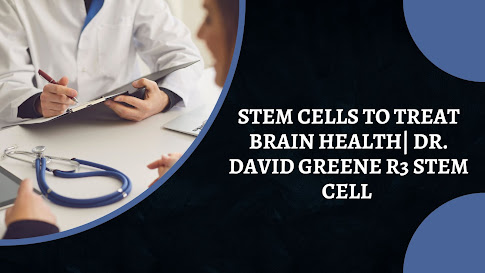Stem Cells to Treat Brain Health| Dr. David Greene R3 Stem Cell
According to specialists like Dr. David Greene R3 Stem Cell, stem cells as medical therapies already influence patients in the clinic. Due to their adaptability and flexibility, these cells are also promising new therapeutic options because they can be employed to cure cancer and restore damaged brain regions.
Exploring Stem Cells as Treatments
The extraordinary ability of stem cells to continuously renew themselves and differentiate into the diverse cell types that make up our bodies, such as muscle, blood, and brain cells, is referred to as self-renewal and differentiation. Stem cells assist the body in maintaining homeostasis, or the condition in which it functions, by regenerating and replacing cells like those in the skin or gut. Because stem cells are essential for recovering and healing injuries, experts use this characteristic of stem cells to speed healing in areas where patients' stem cells haven't been as effective as their baseline capacities for wound healing.
Experts are carrying out clinical trials to address unmet medical needs in populations of patients with neurological diseases and assist in the translation of novel treatment breakthroughs that improve patients' quality of life. Specialists conducted neurosurgical tests to assess the stability and efficacy of stem cells for promoting motor recovery in patients with diverse types of brain injury, such as ischemic stroke and traumatic brain injury (TBI). The blood-brain barrier creates a safe environment for the brain, which encloses and shields it from substances or immune cells that could harm or inflame it. However, the blood-brain barrier also prevents immune system cells from getting to the brain when needed to fight cancer or help recover the brain after an injury like a stroke or concussion.
What's Next?
There is hope that other central nervous system injuries may result in protracted symptoms, according to experts like Dr. David Greene R3 Stem Cell. Examples include brain damage brought on by excessive blood pressure, intracerebral hemorrhage, and neurodegenerative diseases like ALS and dementia. Therefore, to enhance brain function and limit the effects of aging on the brain, it is also essential to keep brain health.
Use of Stem Cells in Regenerative Medicine
Future cellular therapies for neurological diseases may offer the potential benefits of regenerative medicine. The blood-brain barrier allows neurosurgeons to precise control where and how much cellular treatment is delivered to the target location, making the minimally invasive neurosurgical technique suitable for these clinical studies. There is still more research on the consequences of exposing other organs to the cells given systemically and how much the target site will reach the brain. However, less invasive methods of delivering effective medications might be possible.
Stem Cells as Anti-Cancer Agents
Another aspect of stem cells is their capacity to treat cancer. Scientists like Dr. David Greene R3 Stem Cell can take advantage of the stem cell's ability to regenerate by using it as a factory to create new cells in the lab rather than as a growth promoter. They can generate a line of stem cells that can differentiate into certain immune cell types, such as modified T-cells and anti-cancer myeloid cells, which can target and eliminate cancer cells in a targeted manner.
A Look Into the Future
Cellular therapies for regeneration and anti-cancer drugs are available to patients through cutting-edge clinical investigations, and innovative treatment options are in the process. An intriguing new area of new drug design is the development of patient-specific cell lines for use in guiding drug research and therapy selection. In one instance, a small portion of a patient's skin cells might be converted into stem cells and multiplied to make any desired target cell in a petri dish, such as neural cells.
Blog Description:
Dr. David Greene R3 Stem Cell, a stem cell researcher, is working to offer patients with severe illnesses experimental treatments. For instance, he displays these cells' plasticity and flexibility, making them attractive new therapeutic alternatives for treating cancer and repairing damaged brain structures.



Comments
Post a Comment